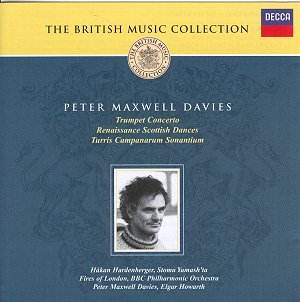There was a time, not that long ago, when every new
work by ‘Max’ was quickly recorded and available. Those were the days,
first, of the Unicorn-Kanchana label (much underrated) and later of
the much-lamented Collins Classics. Now it’s true that some of these
recordings are or will be re-emerging in time, but at present many of
the composer’s major works are not available and his profile has slipped
as a consequence. It is good therefore to welcome this disc from Decca’s
‘British Music Collection’ series. Not only that but these performances
are first class; probably are as good as they come. At medium price
well worth tracking down.
Nevertheless comparisons with other recordings are
of interest; particularly for those of you who have some of this material
on other discs. Lets take the Trumpet Concerto first. Written
for John Wallace and the Philharmonia it was premiered under the late
Giuseppe Sinopoli in Hiroshima in September 1988. Wallace, and Maxwell
Davies went to Glasgow Hall to record it in April 1990 for the Collins
label (11812). Håkan Hardenberger got there first, recording it
under Elgar Howarth in Manchester in the January of that year for Decca.
If you can get the Collins version you will find the fascinating coupling
of the 4th Symphony scored for Chamber Orchestra. Wallace
is a superb player and his performance under the composer is excellent
and has an authentic ring, but Hardenberger is even more sensational.
He is a little more ‘in your face’ as people say, especially emphasised
by the recorded balance, he is also that little bit quicker in the long
first movement which works better, without losing the wonderful atmosphere
of the slow opening. This concerto is inspired by St. Francis preaching
to the birds, and there is a wonderful passage in this movement, better
articulated by Max on Collins, where a raft of bird-calls ensues after
a trumpet cadenza passage, a similar piece of orchestration can be heard
in the third movement of the First Symphony. This concerto though is
a fine work, which for me, after re-acquaintance, has grown in stature.
St. Francis here is of the Orkney isles, windswept and sea soaked.
One niggling disappointment is that although the work
can be divided as it says in the notes into eight changes of tempo,
Decca only allow one track for the entire work. Actually the piece falls
into three movements and Collins considerately allow three tracks.
The CD cover says, confusingly, that the ‘Renaissance
Scottish Dances’ are receiving their ‘first release on CD’.
Well, not so. I have in front of me a Unicorn-Kanchana disc (DKP 9070)
entitled ‘A Celebration of Scotland’ which concludes with these self-same
dances recorded under the composer’s direction (in February 1988) with
members of the Scottish Chamber Orchestra. Again this was a good performance
nicely put together but on this new CD the Fires of London are
even stronger, especially the great Alan Hacker on the ‘folk clarinet’,
and Jennifer Ward Clarke on baroque cello. This is in fact an historic
recording; a memory of those marvellous concerts in the 1970s on BBC
Radio 3 called ‘Music in our Time’ in which Max and his friends often
shocked us with arrangements such as these.
Again only one track has been permitted for this, admittedly,
short piece whereas it would have been helpful, as on the Unicorn-Kanchana
disc if all seven dances had been separately tracked. Is tracking so
hugely expensive?
Whatever possessed Max to write or compile ‘Turris
Campanarium Sonantium’ I’m not quite sure? To quote the composer
writing in the enclosed notes: "it is played entirely on bells
and metal surfaces. The performer enters the playing area very slowly,
sounding a tiny Indian bell, or a set of jingles". He then proceeds
to articulate the form of the piece. It is in four sections ending in
the way it began. The form is clear and makes sense. With its titles
of ‘Stedman Doubles’ (played on cup-shaped Japanese temple gongs)
and Double Bob (for eight handballs) one is reminded of traditional
campanology. The inspiration behind this piece is really Stomu Yamash’ta
himself and Japanese court music. To add to the variety the fourth section
uses Trinidadian steel drums.
So, an intriguing CD of three totally contrasting works
from different periods in Max’s creative life. Excellent performances
and a disc worth adding to your collection. But if you are not a Max
convert then, as the Irishman might say, don’t start here.
Gary Higginson
